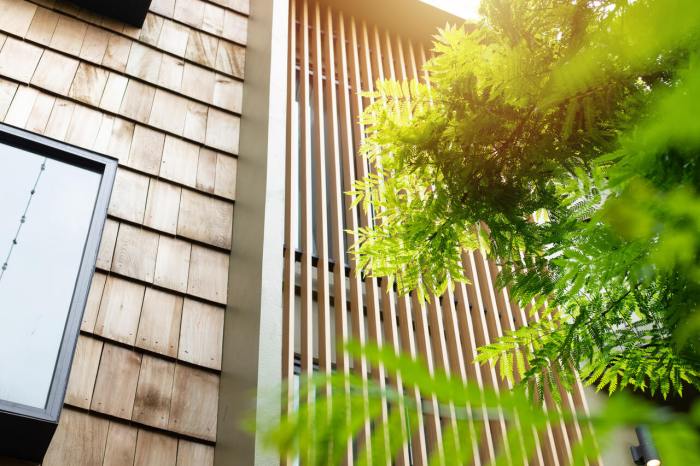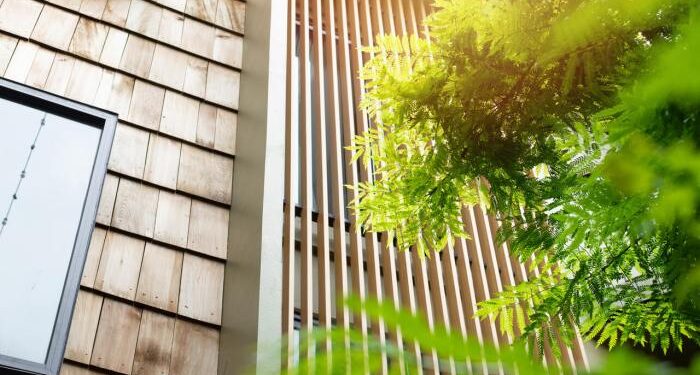Exploring the world of eco-friendly siding options for sustainable buildings opens up a realm of possibilities for environmentally-conscious construction. From recycled materials to energy-efficient solutions, the choices are vast and impactful. Let's delve into the details of these innovative options that not only benefit the environment but also enhance the overall sustainability of buildings.
As we navigate through the various categories of eco-friendly siding materials, we will uncover the unique characteristics and advantages they offer, shedding light on how each choice can make a difference in creating a greener future.
Types of Eco-Friendly Siding Options
When it comes to sustainable building materials, eco-friendly siding options play a crucial role in reducing environmental impact. These siding materials are not only renewable and recyclable but also offer a range of benefits in terms of energy efficiency and durability.
Wood Siding
Wood siding is a popular choice for eco-friendly construction due to its natural and renewable properties. It provides excellent insulation, reducing the need for additional heating or cooling. However, regular maintenance and treatment are required to prevent rot and decay.
Recycled Metal Siding
Using recycled metal for siding is another sustainable option that reduces waste and energy consumption. Metal siding is durable, fire-resistant, and low-maintenance, making it a long-lasting choice for eco-conscious builders.
Fiber Cement Siding
Fiber cement siding is a blend of cement, sand, and cellulose fibers, making it a sturdy and eco-friendly option. It is resistant to rot, insects, and fire, requiring minimal maintenance over its lifespan. Additionally, fiber cement siding can mimic the look of wood or stone without the environmental impact.
Brick Siding
Brick siding offers a timeless and durable option for sustainable buildings. It provides excellent thermal mass, helping regulate indoor temperatures and reducing energy consumption. While the initial cost may be higher, brick siding requires minimal maintenance and has a long lifespan.
Composite Siding
Composite siding is made from a combination of recycled wood fibers and plastic, offering a durable and low-maintenance alternative to traditional wood siding. It is resistant to rot, insects, and fading, making it a sustainable choice for eco-friendly construction projects.
Cost-Effectiveness and Durability
When comparing the cost-effectiveness of different eco-friendly siding materials, factors such as initial installation costs, maintenance requirements, and lifespan should be considered. While some materials may have a higher upfront cost, their durability and low maintenance needs can result in long-term savings.
Environmental Benefits
Using eco-friendly siding options helps reduce the environmental impact of construction projects by promoting sustainability, reducing waste, and conserving natural resources. These materials also contribute to better indoor air quality and energy efficiency, creating healthier and more environmentally friendly buildings.
Recycled and Upcycled Siding Materials
Using recycled and upcycled materials for siding in sustainable construction is a great way to reduce waste and minimize the environmental impact of building projects. These materials not only offer a unique aesthetic appeal but also contribute to the overall sustainability of the structure.
Examples of Innovative Upcycled Siding Materials
One innovative example of upcycled siding materials is reclaimed wood siding. This type of siding is made from old wood salvaged from barns, factories, or other structures, giving it a rustic and weathered look. Another example is recycled metal siding, which is often made from old metal roofing panels or salvaged metal scraps.
These materials not only add character to a building but also help reduce the demand for new resources.
Process of Sourcing and Utilizing Recycled Materials
The process of sourcing recycled materials for siding involves identifying suitable sources of reclaimed materials, such as old buildings, demolition sites, or salvage yards. These materials are then cleaned, processed, and prepared for use as siding. Utilizing recycled materials requires careful planning and coordination to ensure that the materials meet the required quality standards and can be integrated seamlessly into the construction process.
Aesthetic Appeal and Versatility of Recycled Siding Options
Recycled siding options offer a wide range of aesthetic possibilities, from rustic and industrial looks to sleek and modern designs. The unique textures and colors of recycled materials can add character and charm to a building, creating a one-of-a-kind appearance.
Additionally, recycled siding materials are versatile and can be used in various architectural styles and design concepts, making them a popular choice for eco-conscious builders and designers.
Energy-Efficient Siding Solutions
Energy-efficient siding plays a crucial role in enhancing the overall sustainability of a building by reducing energy consumption and minimizing environmental impact.
Insulation Properties of Energy-Efficient Siding Materials
Energy-efficient siding materials such as insulated vinyl, fiber cement, and engineered wood provide excellent insulation properties. These materials help to maintain a consistent indoor temperature by reducing heat transfer through walls, thus decreasing the need for heating and cooling systems
Impact of Energy-Efficient Siding on Heating and Cooling Costs
- Energy-efficient siding reduces heat loss during winter and heat gain during summer, resulting in lower energy usage for heating and cooling.
- By improving the thermal performance of a building, energy-efficient siding can lead to significant cost savings on utility bills over time.
- Properly insulated siding can also enhance the overall comfort of the indoor environment by minimizing temperature fluctuations.
Selecting the Most Suitable Energy-Efficient Siding for Different Climates
When choosing energy-efficient siding for a building, it is essential to consider the climate of the region to ensure optimal performance. Here are some tips for selecting the most suitable energy-efficient siding:
- For colder climates, opt for insulated siding materials with high R-values to maximize heat retention.
- In warmer climates, choose siding materials with reflective properties to reduce heat absorption and keep the building cool.
- Consult with a professional to determine the best energy-efficient siding options based on the specific climate conditions and energy needs of the building.
Biodegradable and Natural Siding Alternatives
When it comes to siding options for sustainable buildings, biodegradable and natural materials offer a eco-friendly alternative that can reduce the environmental impact of construction projects.Biodegradable siding materials are made from organic compounds that break down naturally over time, reducing waste and pollution.
These materials can include plant-based fibers, such as hemp or flax, as well as recycled paper or cardboard. By choosing biodegradable siding options, builders can help minimize their carbon footprint and contribute to a more sustainable future.Natural siding alternatives, such as wood, bamboo, or cork, are also popular choices for eco-conscious builders.
These materials are renewable, biodegradable, and have a lower environmental impact compared to traditional siding options like vinyl or aluminum. Wood siding, in particular, is known for its durability and timeless aesthetic, making it a popular choice for sustainable construction projects.
Comparing Biodegradable Siding Materials
- Biodegradable siding materials are compostable and can return nutrients to the soil.
- These materials have a lower embodied energy compared to conventional siding options.
- Biodegradable siding may require more frequent maintenance and replacement due to natural decomposition.
Non-Toxic Finishes for Biodegradable Siding
- Choosing non-toxic finishes for biodegradable siding products is essential to maintain indoor air quality.
- Natural finishes like linseed oil or beeswax can help protect biodegradable siding materials without harmful chemicals.
- Non-toxic finishes are also safer for the environment during the manufacturing and disposal process.
Closing Notes

In conclusion, the array of eco-friendly siding options discussed above showcases the versatility and effectiveness of sustainable materials in construction. By choosing these environmentally-friendly alternatives, we not only reduce our carbon footprint but also contribute to the longevity and efficiency of our buildings.
Embracing eco-friendly siding is not just a trend – it's a sustainable choice for a greener tomorrow.
Expert Answers
Are eco-friendly siding materials more expensive than traditional options?
Eco-friendly siding materials can have a higher upfront cost, but they often provide long-term savings through energy efficiency and durability, making them a cost-effective choice in the long run.
How do energy-efficient siding solutions impact heating and cooling costs?
Energy-efficient siding can help regulate indoor temperatures, reducing the need for excessive heating or cooling, which can lead to noticeable savings on energy bills.
What are the benefits of using biodegradable siding materials?
Biodegradable siding materials are environmentally friendly, as they break down naturally over time, reducing the impact on landfills and ecosystems.




